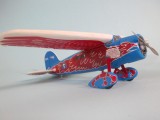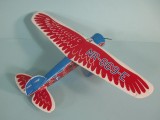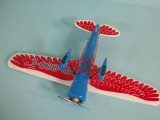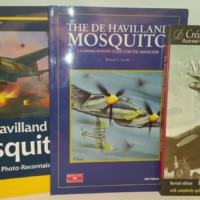Lockheed Vega “Century of Progress”
Designed in 1927, the Lockheed Vega was the first of the Lockheed "Stars" - Altair, Sirius and Orion - and was the Learjet of its day. Aerodynamically clean and constructed of wood with a fully-cantilever airframe, it was capable of 230 mph. As a passenger transport, it could carry up to five passengers. Several famous aviators used the Vega for record-setting flights, including Wiley Post with his two record round-the-world flights and Amelia Earhart's flight across the Atlantic in 1931, the first by a woman.
Jimmy Mattern was a well-known pilot of the 1920s and 30s from Dallas, Texas, a flying buddy of Howard Hughes who had worked as a stunt pilot on "Hells Angels." In 1930, he made the acquaintance of Lockheed Vega Model 5 (S/N 69; ATC #93) manufactured May 16, 1929, licensed NC869E while working for Cromwell Airlines of San Angelo, Texas. In 1931 Mattern bought the Vega from the estate of Mr. Cromwell after he was killed in a flying accident. He was determined to beat the record recently set by Wiley Post and Harold Gatty for flying around the world and obtained the backing of the Standard Oil Company and Clarence Page.
Mattern had NC869E rebuilt and fitted for a round-the-world flight. It was named “Century of Progress” and a new cockpit was fitted behind the wing and dual controls were installed. He and Bennett Griffin began their journey by flying from New York to Newfoundland to Ireland to Berlin, beginning July 5, 1932. from Floyd Bennett Field, New York to Harbor Grace, Newfoundland, and then non-stop to Berlin, Germany in 18:41 hours. They set a new record for crossing the Atlantic Ocean: 10 hours, 50 minutes This Vega crashed after leaving Berlin when the cabin door came off and struck the horizontal stabilizer while they were approaching Borisov airfield in what is now Belarus. They were arrested by the NKVD, taken to Moscow and interrogated as spies before being released
Parts of NC869E were salvaged and shipped back to the USA. Back in America, the fuselage and tail surfaces of a former Standard Oil Vega, NC106N (c/n118) were used with the wing and landing gear of NC869E in a rebuild at Lockheed. Even though the majority of the rebuilt plane was NC106N, Mattern kept the NC869E registration and the same constructor's number (c/n69). Since the fuselage of NC106N was painted with the Standard Oil Stanavo Eagle paint scheme, Mattern simply elaborated on it during the rebuild.
The "new" airplane was flown solo by Mattern. He took off on June 3, 1933, and arrivied June 4 in Norway, well off course from his planned route. He flew on to Moscow then set off for Khabarovsk. He got lost and set down at the Amdamir River, where peasants filled the plane with tractor fuel. NC869E crashed, the result of bad fuel, in Siberia. Mattern was missing for weeks, surviving on his own in the frozen wastes, but he was rescued by Eskimos and Sigizmund Levanevsky. After no small diplomatic juggling, Levanevsky carried him to Nome, Alaska. Mattern then flew another plane from Nome back to New York. In a twist of fate, Mattern would join the search for Levanevsky after he went missing in 1937. Levanevsky was never found..
Mattern became a Lockheed test pilot 1938 and worked on the P-38 Lightning; during the war he helped develop the 'Piggyback' 2-seat version that significantly reduced training accidents. In 1946 he was diagnosed at the Mayo Clinic with a ruptured blood vessel in his brain (perhaps due to repeated excessive g-forces experienced while demonstrating P-38s) and was unable to fly again because of the condition. After losing his ability to fly, Mattern and his wife became real estate brokers and then operated a travel agency. He was a founder of the OX-5 Club for antique aviators and was active in Quiet Birdmen and the Society of Experimental Test Pilots and worked as a producer on the 1960s cartoon series "Space Angel". He also supported the space program.
Neil Armstrong considered Mattern one of his childhood heroes, and wore his Omega Allproof watch on the Gemini-8 mission. Edwin "Buzz" Aldrin carried Mattern's pilot's license to the moon on Apollo-11.
This is the old Lindberg kit, originally released in the late 1950s and re-released this past year. The kit makes up into the Vega VC in the configuration Wiley Post had it in when he flew solo around the world in 1933. The kit is not as accurate as the AMT kit, but far less 'fiddly" and nowhere near the putty hog that kit is. It is a "tall-tail" Vega and that has to be modified to make "Century of Progress," as well as opening a second set of windows behind the windows in the kit. I used the Red Pegasus decals to do the airplane, which was one of the most spectacular finishes carried by any airplane in the 1930s.















Tom, beautiful job! I remember seeing this on the cover of an American Modeler, done by "Cal" Smith, whose covers for them were favorites of mine. The man had a gift. I always wanted to do the plane, but the intricacy of the scheme stopped that pretty quick.
The Vega is just a beauty in and of herself.
Thanks for the trip down aeronautical memory lane in a couple of ways.
Exceptional, Tom. Reminds me of an Okie and a humorist a few people know of.
Will Rogers! We will not see his like again. Mores the pity.
Beautiful! Interesting story behind this aircraft! Thanks for posting this one!
Great subject Tom - nice work!
Looks great. Thought it was a what if at first glance, A nice history lesson .
Now THAT is one colorful bird - and a great story to go with it!
My favourite era in history of flight! Great build and a stunning finish!